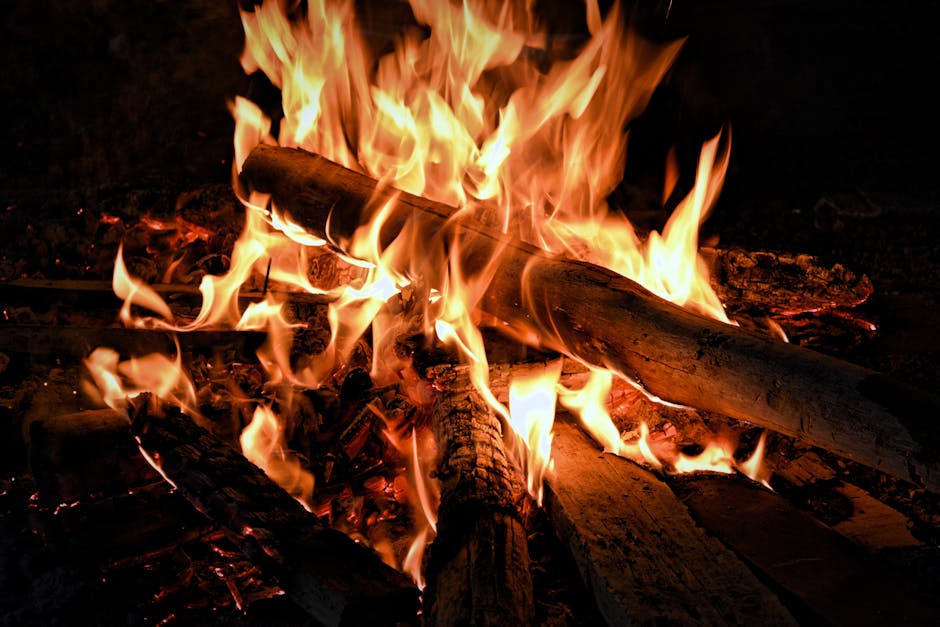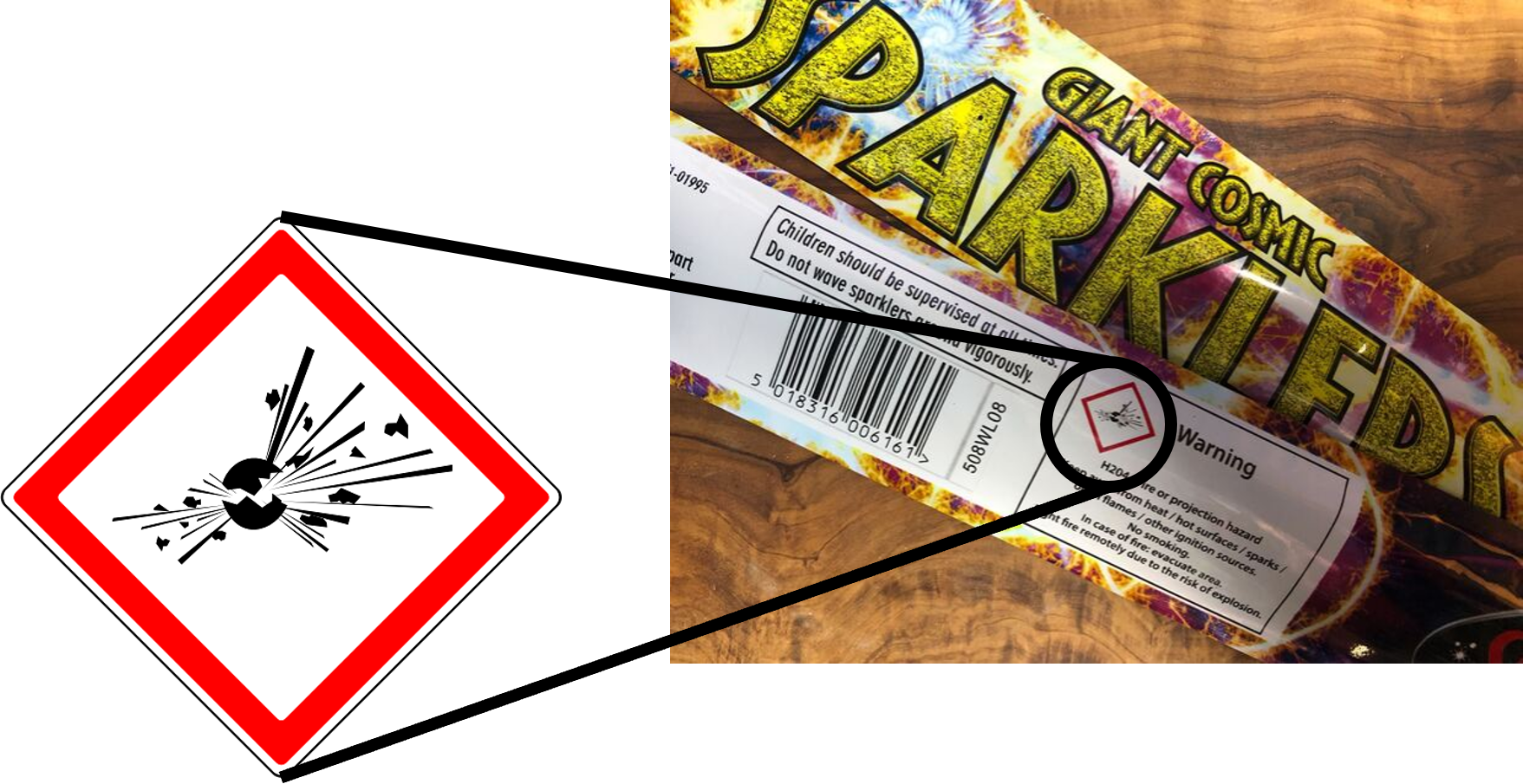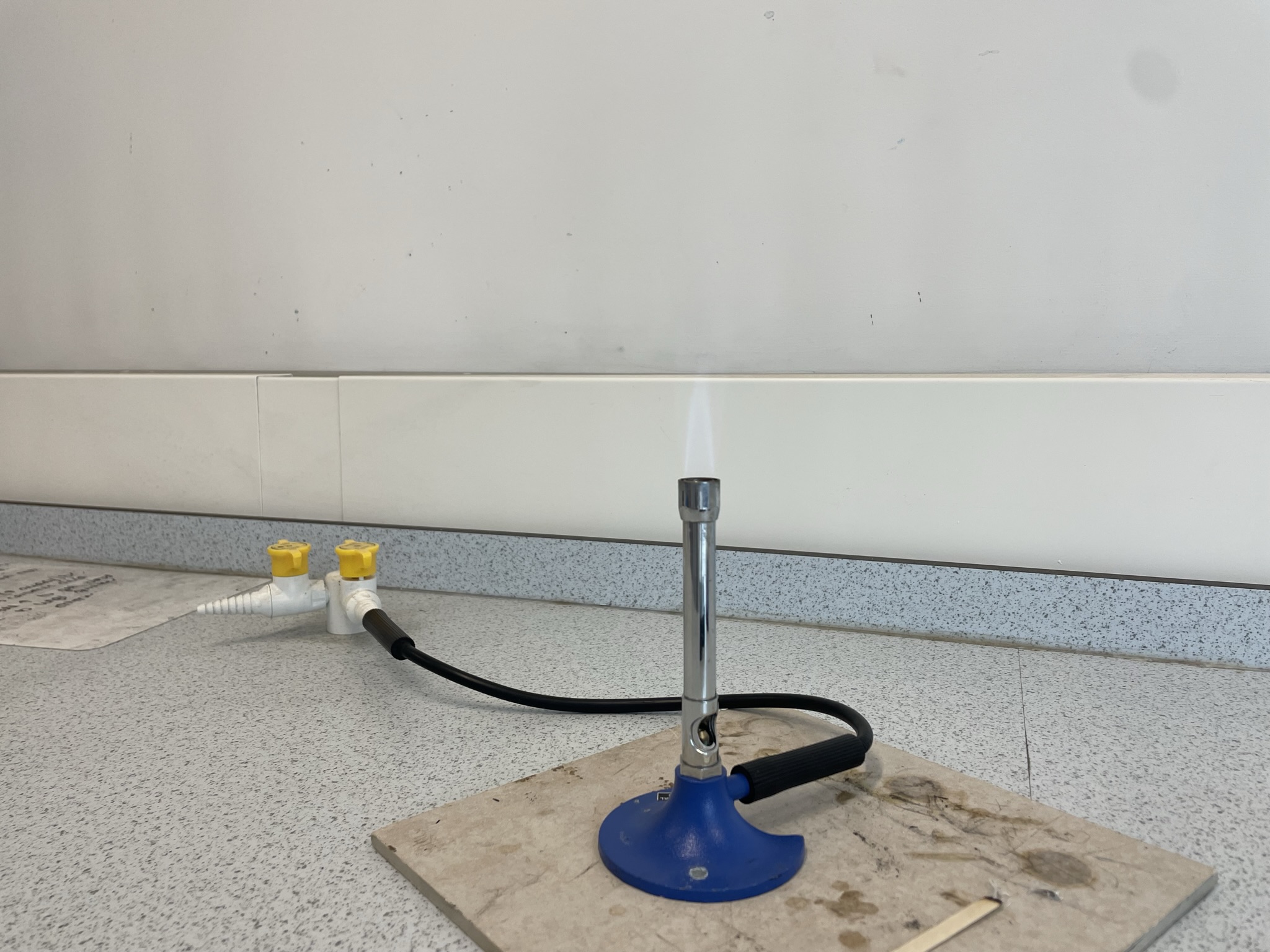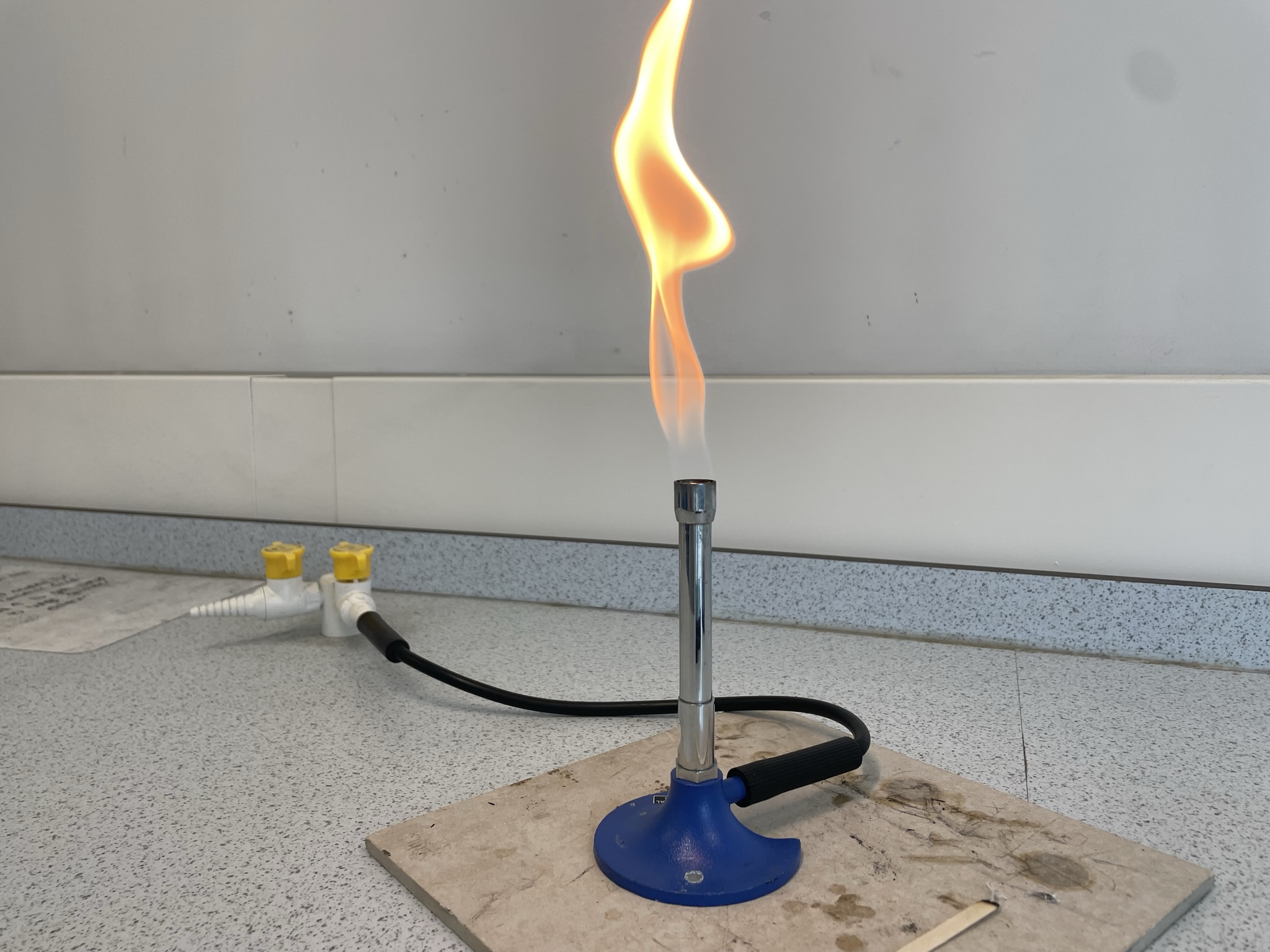
Combustion (GCSE)
Skip to:
Combustion, also known as burning, is an exothermic reaction. Sometimes, this reaction also produces light, resulting in a flame. Combustion is central to many everyday processes, from running car engines to heating our homes.

Combustion specifically refers to the oxidation of a substance, where a fuel reacts with an oxidant, usually oxygen, to produce oxidised products and release heat. The term "burning" is often used more generally to describe the process of combustion that produces a flame.

The fire triangle is a model for understanding the necessary ingredients for most fires. It consists of three components:
- Fuel: A material that will combust.
- Oxygen: The gas that supports combustion.
- Heat: Energy to first initiate, and then sustain, the reaction.

Explosions are rapid combustive reactions that result in a sudden expansion of gases, producing a shock wave. Proper ventilation and maintenance are crucial to prevent such dangerous situations.
Complete Combustion
Complete combustion happens when there is plenty of oxygen available. This ensures that a fuel burns fully, producing carbon dioxide (CO₂) and water (H₂O) as the main products.
hydrocarbon fuel + oxygen → carbon dioxide + water
Example with methane (CH₄):
- methane + oxygen → carbon dioxide + water
- CH₄ (g) + 2O₂ (g) → CO₂ (g) + 2H₂O (g)
In complete combustion, the fuel burns efficiently and releases the maximum amount of energy. This type of combustion is desirable in engines and power plants because it ensures that the fuel is used efficiently and produces fewer pollutants. For example, in a car engine, complete combustion of petrol (a hydrocarbon) produces carbon dioxide and water, which are less harmful compared to the products of incomplete combustion.
Complete combustion generally produces minimal smoke because the fuel is entirely converted to carbon dioxide and water.

In the laboratory, a Bunsen burner can be adjusted to achieve complete combustion. When the air hole is fully open, allowing maximum oxygen to mix with the gas, it produces a blue flame. This blue flame indicates complete combustion, providing a hot and efficient heat source with minimal soot production.
Incomplete Combustion
When there isn't enough oxygen to allow the fuel to react completely, incomplete combustion occurs. This can produce a variety of products, including carbon monoxide (CO), soot (carbon, C), and water. Often some carbon dioxide will be produced, but we don't often write that in these equations to show a clear difference from complete combustion.
hydrocarbon fuel + oxygen → carbon monoxide + carbon (soot) + water + some carbon dioxide
Example with methane (CH₄):
- methane + oxygen → carbon monoxide + water + carbon (soot)
- 2CH₄ (g) + 3O₂ (g) → 2CO (g) + 4H₂O (g) + C (s)
Incomplete combustion can produce carbon monoxide, which is a poisonous gas, and soot, which is made of tiny particles of carbon. Carbon monoxide can bind with haemoglobin in the blood, preventing it from carrying oxygen. This can lead to carbon monoxide poisoning, which is life-threatening. Soot, on the other hand, can cause respiratory problems and contribute to environmental pollution.

Because not all the fuel is converted into carbon dioxide and water, incomplete combustion typically produces more smoke (than complete combustion). The smoke contains particles of soot and unburned hydrocarbons.

Incomplete combustion can occur in household appliances like boilers and heaters if they are not properly maintained. It is essential to ensure that these appliances have adequate ventilation and are serviced regularly to prevent incomplete combustion and the associated risks.
Carbon monoxide detectors detect the presence of carbon monoxide. They are crucial for homes with gas appliances, as they provide early warning of carbon monoxide leaks, allowing occupants to evacuate and seek help.

In the laboratory, a Bunsen burner can also demonstrate incomplete combustion. When the air hole is closed, limiting the oxygen supply, it produces an orange, sooty flame. This orange flame indicates incomplete combustion, resulting in a cooler flame (compared to a blue flame, but still very hot!) with more soot and unburned hydrocarbons.
Fire Extinguishers
Different types of fire extinguishers are used to tackle different kinds of fires by removing one or more parts the fire triangle (fuel, oxygen, or heat). Here's a table summarising the main types and their uses:
| type | Class A: solid combustibles (such as wood, paper & textiles) |
Class B: flammable liquids (such as petrol, diesel & paraffin) |
Class C: flammable gases (such as methane, propane & hydrogen) |
Class D: flammable metals (such as magnesium, aluminium & lithium) |
Electrical: (such as computers & electric heaters) | Class F: cooking oil (such as deep fat fryers & chip pans) |
|---|---|---|---|---|---|---|
| water | ||||||
| water mist | ||||||
| carbon dioxide (CO₂) | ||||||
| dry powder | ||||||
| wet chemical | sometimes | |||||
| foam | ||||||

Fire blankets are safety devices designed to extinguish small fires. They are made of fire-resistant materials and can be used to smother fires by cutting off the oxygen supply. Fire blankets are particularly useful in kitchens for dealing with small grease fires and in laboratories for putting out fires on clothing. To use a fire blanket, you should carefully place it over the fire, ensuring it covers the entire area, and then leave it in place until the fire is completely extinguished. It's important to note that fire blankets are most effective for small fires, and in case of larger fires, it's best to evacuate and call the fire brigade.

Fire alarms are essential safety devices that detect the presence of fire and alert occupants to evacuate. There are different types of fire alarms, including manual and automatic alarms. Some automatic ones include: smoke detectors and heat alarms.
- Smoke detectors detect smoke particles in the air. Traditional smoke detectors used alpha radiation to ionise the air between two electrodes. When smoke entered the detector, it disrupted the ionisation process, triggering the alarm. Modern smoke detectors use optical sensors to detect smoke. They are effective for detecting smouldering fires that produce a lot of smoke but little heat.
- Heat alarms detect a rapid rise in temperature or a specific high temperature. They are suitable for areas where smoke detectors may produce false alarms, such as kitchens and garages. Heat alarms are ideal for detecting flaming fires that generate significant heat.
Listen to this page (feature coming soon)
Did you know?
- The first fire extinguisher was invented by George William Manby in 1818.
- Carbon monoxide is colourless and odourless, making it difficult to detect. This is why carbon monoxide detectors are essential in homes.
- The ancient Greeks used a type of flame weapon called "Greek fire" in naval battles. It was a combustible compound that could continue burning even on water.
- The colours of fireworks are created by different metal salts undergoing combustion. For example, strontium salts produce red, copper salts produce blue, and sodium salts produce yellow.
- Spontaneous combustion can occur in materials like oily rags when they are left in a pile, as heat build-up from oxidation reactions can ignite the material without an external flame (though it does not occur in humans).
Why do we care?
- Understanding combustion helps us use fuels efficiently and safely.
- Knowing the products of incomplete combustion is crucial for preventing poisoning and pollution.
- Fire safety knowledge, including the use of extinguishers and alarms, is vital for handling emergencies and protecting lives.
Key information
- Combustion requires fuel, oxygen, and heat.
- Complete combustion produces carbon dioxide and water.
- Incomplete combustion can produce carbon monoxide and soot, as well as always producing water.
- Different fire extinguishers are designed for different types of fires.
- Fire blankets are effective for small fires.
- Different fire alarms provide early warning for various fire hazards.